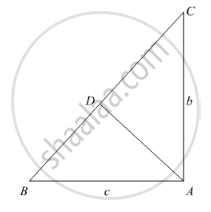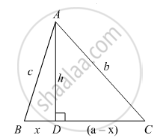Advertisements
Advertisements
प्रश्न
Using Pythagoras theorem determine the length of AD in terms of b and c shown in Figure.
उत्तर

We have,
In ΔBAC, by Pythagoras theorem
BC2 = AB2 + AC2
⇒ BC2 = c2 + b2
⇒ BC = `sqrt(c^2+b^2)` ........(i)
In ΔABD and ΔCBA
∠B = ∠B [Common]
∠ADB = ∠BAC [Each 90°]
Then, ΔABD ~ ΔCBA [By AA similarity]
`therefore"AB"/"CB"="AD"/"CA"` [Corresponding parts of similar Δ are proportional]
`rArrc/sqrt(c^2+b^2)="AD"/b`
`rArr"AD"="bc"/sqrt(c^2+b^2)`
APPEARS IN
संबंधित प्रश्न
If the sides of a triangle are 3 cm, 4 cm, and 6 cm long, determine whether the triangle is a right-angled triangle.
In an isosceles triangle ABC, AB = AC = 25 cm, BC = 14 cm. Calculate the altitude from A on BC.
A triangle has sides 5 cm, 12 cm and 13 cm. Find the length to one decimal place, of the perpendicular from the opposite vertex to the side whose length is 13 cm.
Each side of a rhombus is 10 cm. If one of its diagonals is 16 cm find the length of the other diagonal.
In right-angled triangle ABC in which ∠C = 90°, if D is the mid-point of BC, prove that AB2 = 4AD2 − 3AC2.
In the given figure, ∠B < 90° and segment AD ⊥ BC, show that
(i) b2 = h2 + a2 + x2 - 2ax
(ii) b2 = a2 + c2 - 2ax

∆ABD is a right triangle right-angled at A and AC ⊥ BD. Show that
(i) AB2 = BC x BD
(ii) AC2 = BC x DC
(iii) AD2 = BD x CD
(iv) `"AB"^2/"AC"^2="BD"/"DC"`
Find the length of each side of a rhombus whose diagonals are 24cm and 10cm long.
From given figure, In ∆ABC, AB ⊥ BC, AB = BC, AC = `2sqrt(2)` then l (AB) = ?
In a ΔABC, ∠CAB is an obtuse angle. P is the circumcentre of ∆ABC. Prove that ∠CAB – ∠PBC = 90°.
